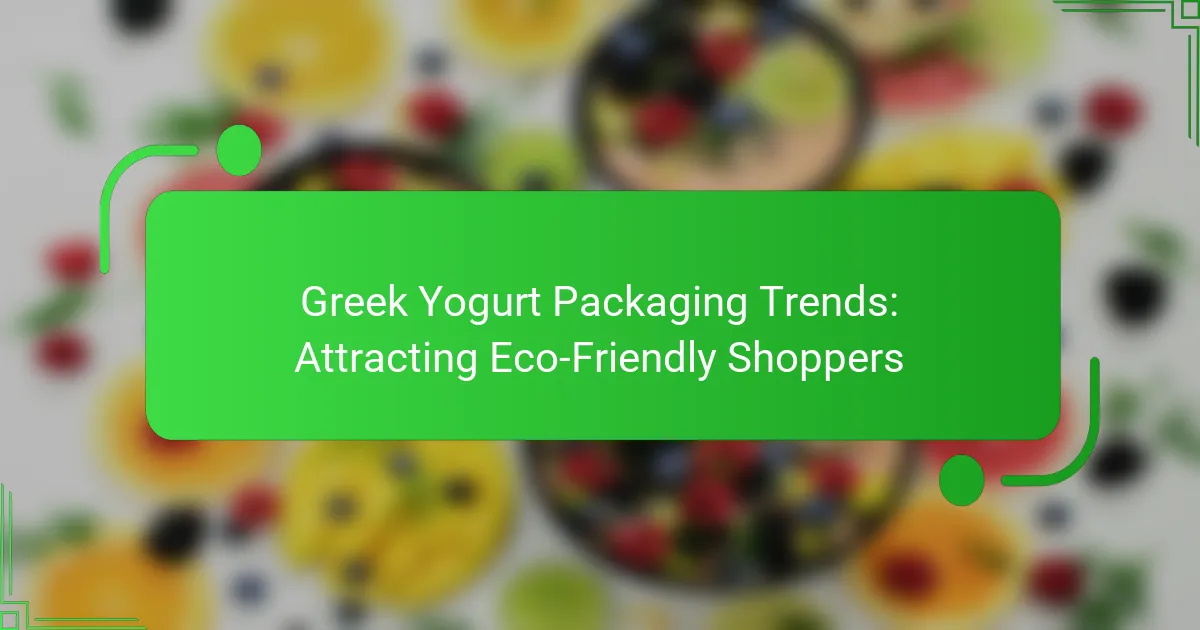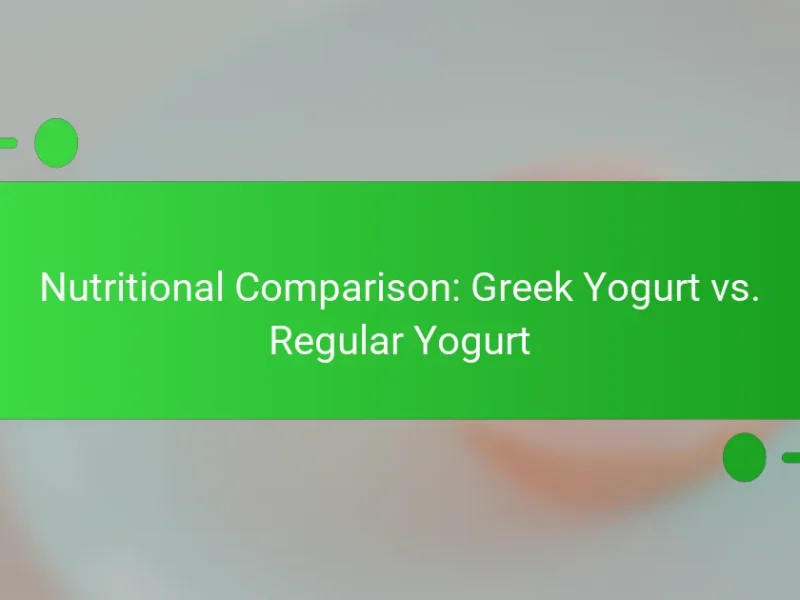Greek yogurt packaging is increasingly focusing on sustainability and convenience, with brands adopting eco-friendly materials such as biodegradable plastics and recyclable containers. Current trends include minimalist designs, single-serve options for on-the-go consumption, and transparent packaging that highlights product quality. Despite the benefits of eco-friendly packaging, brands face challenges such as higher costs, sourcing difficulties, consumer skepticism, regulatory compliance, and ensuring product integrity. These sustainable practices not only reduce environmental impact but also appeal to a growing segment of eco-conscious consumers, enhancing brand loyalty and image.
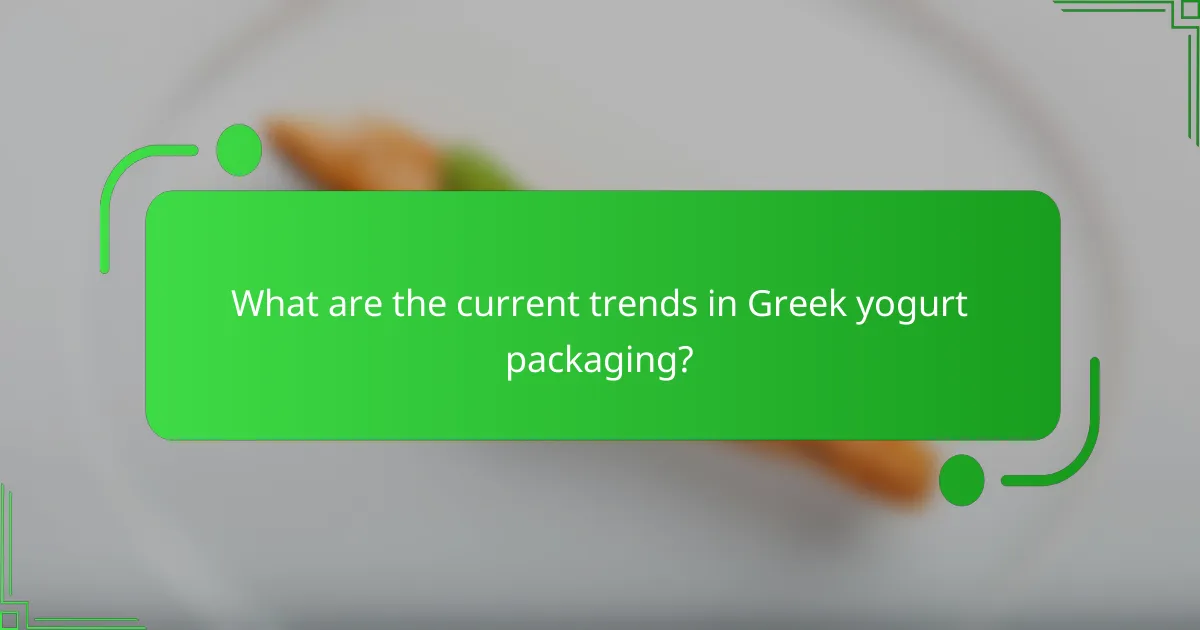
What are the current trends in Greek yogurt packaging?
Current trends in Greek yogurt packaging focus on sustainability and convenience. Many brands are adopting eco-friendly materials like biodegradable plastics and recyclable containers. Minimalist designs are gaining popularity, emphasizing simplicity and clarity. Single-serve packaging options are also trending for on-the-go consumption. Additionally, brands are using transparent packaging to showcase product quality. There is a noticeable shift towards bulk packaging to reduce waste. Innovations in resealable packaging are enhancing product freshness and usability. These trends align with consumer demand for environmentally responsible products.
How are brands adapting their packaging to attract eco-friendly shoppers?
Brands are adapting their packaging to attract eco-friendly shoppers by using sustainable materials. Many companies are shifting to biodegradable or recyclable packaging options. This change meets the increasing consumer demand for environmentally responsible products. For instance, brands are utilizing plant-based plastics and paper from responsibly sourced forests. They also emphasize minimalistic designs that reduce waste. Furthermore, some brands are incorporating refillable containers to promote reuse. Research shows that 73% of consumers prefer brands that use eco-friendly packaging. This trend highlights the importance of sustainability in consumer purchasing decisions.
What materials are being used in sustainable Greek yogurt packaging?
Sustainable Greek yogurt packaging primarily uses materials like biodegradable plastics, recycled paper, and glass. Biodegradable plastics are designed to break down more easily in the environment. Recycled paper is sourced from post-consumer waste, reducing the need for virgin materials. Glass containers are reusable and recyclable, contributing to a circular economy. These materials align with eco-friendly practices and consumer preferences for sustainability. Research indicates that 60% of consumers prefer brands that use sustainable packaging.
How does packaging design influence consumer perceptions of sustainability?
Packaging design significantly influences consumer perceptions of sustainability. Eco-friendly packaging materials, such as biodegradable or recyclable options, enhance the perceived environmental responsibility of a product. Visual elements, like earthy colors and natural imagery, can evoke a sense of eco-consciousness. Clear labeling of sustainability claims, such as “recyclable” or “made from recycled materials,” increases consumer trust. Research shows that 66% of consumers prefer brands that use sustainable packaging (Nielsen, 2018). Additionally, innovative packaging designs that reduce waste can positively impact brand loyalty. These factors collectively shape consumer attitudes toward the sustainability of products, particularly in markets like Greek yogurt.
Why is eco-friendly packaging important for Greek yogurt brands?
Eco-friendly packaging is important for Greek yogurt brands because it aligns with consumer demand for sustainable products. Many consumers prefer brands that minimize environmental impact. Eco-friendly packaging reduces plastic waste, a significant concern in the dairy industry. Research shows that 73% of consumers are willing to pay more for sustainable packaging. Additionally, eco-friendly materials can enhance brand reputation and loyalty. Brands that adopt sustainable practices often see increased sales. The shift towards eco-friendly packaging is not just a trend; it is becoming a market standard. This shift helps Greek yogurt brands differentiate themselves in a competitive market.
What impact does sustainable packaging have on brand loyalty?
Sustainable packaging positively impacts brand loyalty. Consumers increasingly prefer brands that demonstrate environmental responsibility. A study by Nielsen found that 66% of global consumers are willing to pay more for sustainable brands. This willingness enhances customer retention and encourages repeat purchases. Brands using sustainable packaging often experience a stronger emotional connection with their customers. This connection fosters trust and promotes long-term loyalty. Additionally, sustainable packaging can differentiate a brand in a crowded market. This differentiation can attract eco-conscious shoppers, further solidifying brand loyalty.
How does eco-friendly packaging affect sales and market share?
Eco-friendly packaging positively affects sales and market share. Consumers increasingly prefer sustainable products, driving demand for brands that utilize eco-friendly materials. A study by Nielsen shows that 73% of millennials are willing to pay more for sustainable offerings. This trend leads to increased brand loyalty and repeat purchases. Companies adopting eco-friendly packaging often experience a boost in market share. For instance, brands like Chobani have reported sales growth linked to their commitment to sustainability. Eco-friendly packaging also enhances brand image, attracting environmentally conscious consumers. Overall, the shift towards sustainability in packaging is a significant factor in sales performance and market presence.
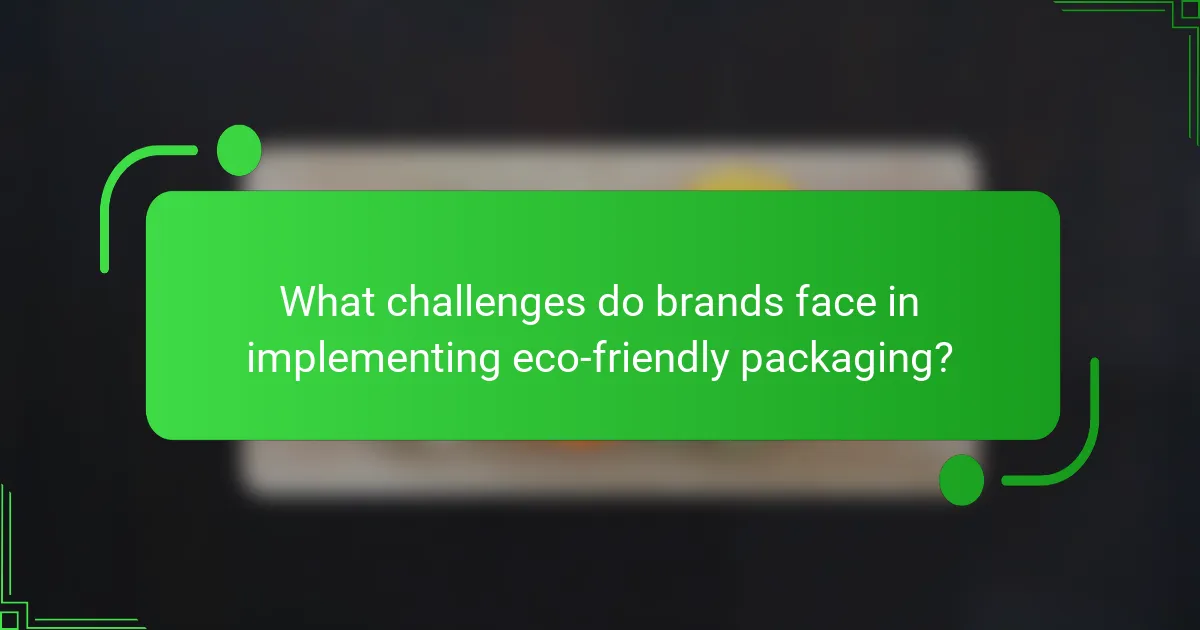
What challenges do brands face in implementing eco-friendly packaging?
Brands face several challenges in implementing eco-friendly packaging. One major challenge is the higher cost associated with sustainable materials. Eco-friendly options often have a premium price compared to traditional packaging. This can impact profit margins and pricing strategies.
Another challenge is the availability and sourcing of sustainable materials. Not all brands have easy access to eco-friendly suppliers. This can lead to delays in production and supply chain issues.
Additionally, consumer perception plays a role. Some consumers may not trust eco-friendly claims or understand the benefits. Brands must invest in education and marketing to address this skepticism.
Regulatory compliance can also be complex. Different regions have varying regulations regarding packaging materials. Brands must navigate these legal requirements to avoid penalties.
Finally, the technical performance of eco-friendly packaging can be a concern. Brands need to ensure that sustainable options maintain product integrity and shelf life. This requires testing and innovation, which can be resource-intensive.
What are the cost implications of sustainable packaging options?
Sustainable packaging options often incur higher initial costs compared to traditional packaging. These costs arise from the use of eco-friendly materials, which can be more expensive to source and produce. For example, biodegradable plastics and recycled materials typically have a higher price point than conventional plastics. Additionally, the manufacturing processes for sustainable packaging can require more advanced technology and equipment, contributing to increased production costs. However, sustainable packaging may lead to long-term savings by reducing waste disposal fees and improving brand loyalty among eco-conscious consumers. A study by Smithers Pira indicates that the global market for sustainable packaging is expected to reach $500 billion by 2027, reflecting growing consumer demand and potential for cost efficiency over time.
How do production processes change with eco-friendly materials?
Production processes change significantly with eco-friendly materials. These materials often require different sourcing and handling methods. For instance, bioplastics may need lower processing temperatures compared to traditional plastics. This can reduce energy consumption during production. Additionally, manufacturers may need to adapt machinery for new material types. The use of recycled materials can also lead to variations in quality control processes. Companies often implement more sustainable practices to align with eco-friendly goals. According to a study by the Ellen MacArthur Foundation, transitioning to sustainable materials can reduce carbon emissions by up to 70%. This shift is crucial for attracting eco-conscious consumers in the Greek yogurt market.
What logistical issues arise from using sustainable packaging?
Sustainable packaging can create several logistical issues. These issues include increased costs, limited availability of materials, and challenges in supply chain management. Sustainable materials may be more expensive than traditional options, affecting overall product pricing. Additionally, sourcing these materials can be difficult due to lower production volumes. This can lead to delays in packaging supply. Transportation logistics may also be impacted, as some sustainable materials require different handling processes. Moreover, the integration of sustainable packaging into existing production lines can necessitate equipment upgrades. These factors can complicate the logistics of distributing Greek yogurt products effectively.
How can brands overcome these challenges?
Brands can overcome challenges in attracting eco-friendly shoppers by adopting sustainable packaging solutions. Implementing biodegradable materials reduces environmental impact. Utilizing recyclable packaging encourages responsible consumer behavior. Clear labeling of eco-friendly attributes builds trust with consumers. Engaging in transparent sourcing practices enhances brand credibility. Collaborating with environmental organizations can amplify sustainability efforts. Offering incentives for recycling can motivate consumer participation. These strategies align with the growing demand for sustainable products, as 66% of global consumers are willing to pay more for eco-friendly brands.
What strategies can be employed to reduce costs associated with eco-friendly packaging?
Utilizing bulk purchasing of materials can significantly reduce costs associated with eco-friendly packaging. This strategy allows companies to negotiate lower prices with suppliers. Implementing efficient design can also minimize material usage and waste. For example, optimizing the shape of containers can reduce the amount of material needed. Switching to local suppliers can lower transportation costs and support sustainability. Investing in reusable packaging systems can yield long-term savings by reducing the need for single-use materials. Conducting lifecycle assessments helps identify cost-saving opportunities in the packaging process. Finally, engaging in collaborative initiatives with other brands can spread costs and encourage innovation in sustainable packaging solutions.
How can collaboration with suppliers enhance sustainability efforts?
Collaboration with suppliers can enhance sustainability efforts by integrating eco-friendly materials into packaging. This partnership allows brands to source sustainable options that reduce environmental impact. Suppliers often possess expertise in sustainable practices and materials. By working together, brands can innovate packaging solutions that are both functional and environmentally responsible. For instance, using biodegradable or recyclable materials can significantly lower waste. Research shows that companies that engage in sustainable supply chain practices can reduce their carbon footprint by up to 30%. Collaborative efforts also foster transparency in sourcing, which builds consumer trust. Overall, supplier collaboration is crucial for achieving comprehensive sustainability in packaging.
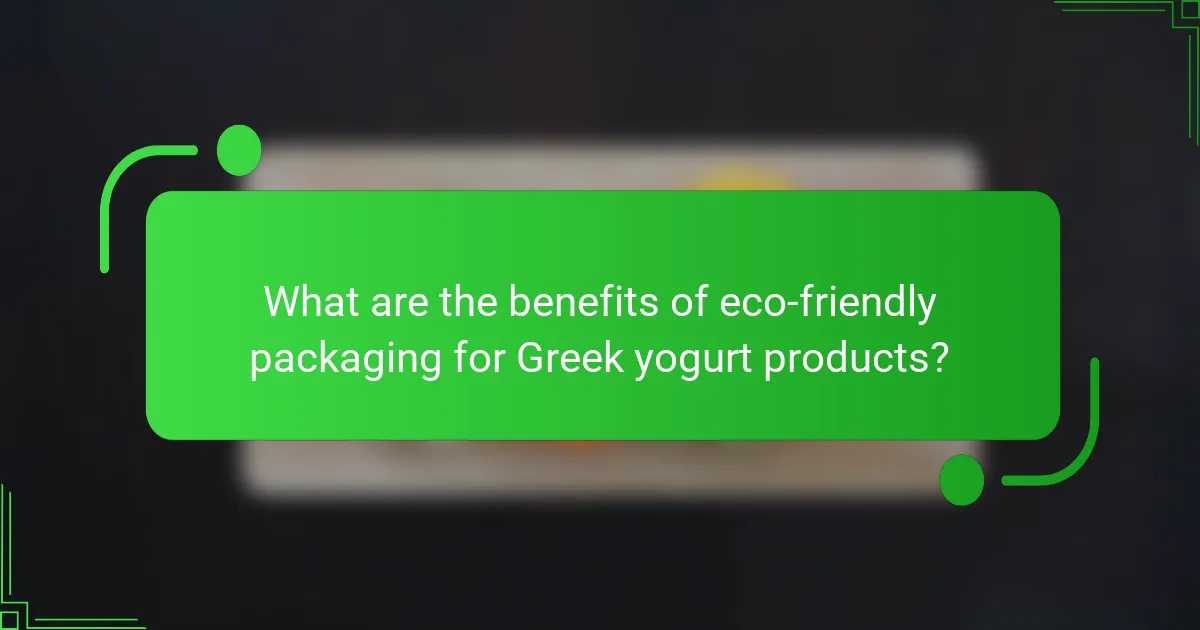
What are the benefits of eco-friendly packaging for Greek yogurt products?
Eco-friendly packaging for Greek yogurt products offers numerous benefits. It reduces environmental impact by minimizing plastic waste. Such packaging is often made from biodegradable or recyclable materials. This appeal to sustainability can attract eco-conscious consumers. Studies show that 66% of consumers prefer brands that use sustainable packaging. Eco-friendly packaging can enhance brand image and loyalty. It often leads to lower carbon footprints during production and disposal. Additionally, it can improve product freshness and shelf life through innovative materials.
How does eco-friendly packaging contribute to environmental sustainability?
Eco-friendly packaging contributes to environmental sustainability by reducing waste and minimizing resource consumption. It is made from renewable materials, which helps decrease reliance on fossil fuels. Additionally, eco-friendly packaging is often biodegradable or recyclable. This leads to less pollution and lower landfill contributions. According to the Ellen MacArthur Foundation, effective packaging design can reduce packaging waste by up to 50%. Furthermore, using sustainable materials can lower carbon emissions significantly, promoting a healthier planet. By adopting eco-friendly packaging, brands can align with consumer preferences for sustainability, driving positive environmental change.
What are the long-term benefits for the planet?
The long-term benefits for the planet include reduced waste and lower carbon emissions. Eco-friendly packaging materials, such as biodegradable or recyclable options, minimize landfill contributions. These materials can decompose naturally, enhancing soil health. Additionally, sustainable packaging reduces the energy required for production. This leads to decreased greenhouse gas emissions. The shift towards eco-friendly practices encourages responsible consumer behavior. Over time, this can foster a culture of sustainability. The adoption of these practices can support biodiversity and protect ecosystems. Ultimately, these efforts contribute to a healthier planet for future generations.
How does eco-friendly packaging reduce waste in the supply chain?
Eco-friendly packaging reduces waste in the supply chain by minimizing non-biodegradable materials. It often uses renewable resources like plant-based plastics and recycled paper. These materials break down naturally, leading to less landfill waste. Additionally, eco-friendly packaging typically employs lighter designs. This reduction in weight decreases transportation emissions and energy use. Studies show that companies using sustainable packaging can cut their waste by up to 30%. Furthermore, eco-friendly options often encourage recycling and reuse. This promotes a circular economy, further reducing overall waste in the supply chain.
What consumer trends support the shift towards sustainable packaging?
Consumers increasingly prefer sustainable packaging due to heightened environmental awareness. A 2021 survey showed that 72% of consumers are willing to pay more for eco-friendly packaging. This trend is driven by a growing concern over plastic waste and climate change. Additionally, younger generations prioritize brands that demonstrate sustainability efforts. Research indicates that 81% of millennials expect brands to be environmentally responsible. Companies that adopt sustainable packaging often see increased customer loyalty. The demand for transparency in sourcing and materials further supports this shift. Brands that align with consumer values on sustainability tend to outperform competitors in market share.
How do eco-conscious consumers influence market trends?
Eco-conscious consumers significantly influence market trends by driving demand for sustainable products. Their preferences lead brands to adopt eco-friendly packaging solutions. For instance, a Nielsen report shows that 73% of millennials are willing to pay more for sustainable products. This behavior pushes companies to innovate in packaging materials. Brands are increasingly using recyclable and biodegradable materials to attract these consumers. Additionally, eco-conscious consumers often prioritize transparency in sourcing and production. This demand for accountability encourages brands to disclose their sustainability practices. As a result, companies that align with eco-friendly values often gain a competitive advantage in the market.
What role does education play in consumer choices related to packaging?
Education significantly influences consumer choices related to packaging. Consumers with higher education levels often prioritize sustainability and environmental impact. They are more likely to choose packaging that is recyclable or made from renewable resources. Research indicates that educated consumers are aware of the implications of packaging waste on the environment. This awareness drives them to seek out products with eco-friendly packaging. Furthermore, educational initiatives can enhance consumer understanding of packaging materials and their effects. Studies show that informed consumers tend to favor brands that demonstrate a commitment to sustainable practices. Therefore, education plays a critical role in shaping consumer preferences for packaging in the context of eco-friendly products like Greek yogurt.
What best practices should brands follow for eco-friendly Greek yogurt packaging?
Brands should prioritize recyclable materials for eco-friendly Greek yogurt packaging. Using materials like glass, paper, or biodegradable plastics reduces environmental impact. Brands can also implement minimalistic designs to decrease material usage. Incorporating clear recycling instructions on packaging encourages consumer participation. Sourcing materials from sustainable suppliers ensures a lower carbon footprint. Utilizing lightweight packaging reduces transportation emissions. Engaging in take-back programs promotes recycling and reuse. By following these practices, brands contribute to sustainability while appealing to eco-conscious consumers.
Greek yogurt packaging trends are increasingly focused on sustainability and convenience, with brands adopting eco-friendly materials such as biodegradable plastics and recyclable containers. Minimalist designs and single-serve options are gaining popularity, catering to on-the-go consumers. The article explores how brands are adapting their packaging to attract eco-conscious shoppers, the materials being used, and the impact of packaging design on consumer perceptions of sustainability. It also addresses the challenges brands face in implementing eco-friendly packaging and the strategies they can employ to overcome these obstacles while enhancing brand loyalty and sales.
